Sub-Immunosuppressive Tacrolimus Ameliorates Amyloid-Beta and Tau Pathology in 3xTg-AD Mice
Abstract
1. Introduction
2. Results
2.1. Tacrolimus Concentration
2.2. Protein Analysis in 3xTg-AD Mice
3. Discussion
4. Materials and Methods
4.1. Animals
4.2. Tacrolimus Treatment
4.3. Liquid Chromatography Tandem Mass Spectrometry
4.4. Immunofluorescence
4.5. Western Blot Analysis
4.6. Data Analysis
5. Conclusions
Supplementary Materials
Author Contributions
Funding
Institutional Review Board Statement
Informed Consent Statement
Data Availability Statement
Acknowledgments
Conflicts of Interest
References
- Rao, Y.L.; Ganaraja, B.; Murlimanju, B.V.; Joy, T.; Krishnamurthy, A.; Agrawal, A. Hippocampus and its involvement in Alzheimer’s disease: A review. 3 Biotech 2022, 12, 55. [Google Scholar] [CrossRef]
- Tacrolimus (systemic): Drug information. In UpToDate; Lexicomp: Hudson, OH, USA, 2023.
- Hong, H.S.; Hwang, J.Y.; Son, S.M.; Kim, Y.H.; Moon, M.; Inhee, M.J. FK506 reduces amyloid plaque burden and induces MMP-9 in AβPP/PS1 double transgenic mice. J. Alzheimer’s Dis. 2010, 22, 97–105. [Google Scholar] [CrossRef] [PubMed]
- Kumar, A.; Singh, N. Calcineurin inhibitors improve memory loss and neuropathological changes in mouse model of dementia. Pharmacol. Biochem. Behav. 2017, 153, 147–159. [Google Scholar] [CrossRef] [PubMed]
- Taglialatela, G.; Hogan, D.; Zhang, W.R.; Dineley, K.T. Intermediate- and long-term recognition memory deficits in Tg2576 mice are reversed with acute calcineurin inhibition. Behav. Brain Res. 2009, 200, 95–99. [Google Scholar] [CrossRef] [PubMed]
- Stallings, N.R.; O’Neal, M.A.; Hu, J.; Shen, Z.J.; Malter, J.S. Long-term normalization of calcineurin activity in model mice rescues Pin1 and attenuates Alzheimer’s phenotypes without blocking peripheral T cell IL-2 response. Alzheimer’s Res. Ther. 2023, 15, 179. [Google Scholar] [CrossRef] [PubMed]
- Marcatti, M.; Tumurbaatar, B.; Borghi, M.; Guptarak, J.; Zhang, W.-R.; Krishnan, B.; Kayed, R.; Fracassi, A.; Taglialatela, G. Inhibition of Calcineurin with FK506 Reduces Tau Levels and Attenuates Synaptic Impairment Driven by Tau Oligomers in the Hippocampus of Male Mouse Models. Int. J. Mol. Sci. 2024, 25, 9092. [Google Scholar] [CrossRef] [PubMed]
- Radhakrishnan, H.; Ubele, M.F.; Krumholz, S.M.; Boaz, K.; Mefford, J.L.; Jones, E.D.; Meacham, B.; Smiley, J.; Puskás, L.G.; Powell, D.K.; et al. Tacrolimus Protects against Age-Associated Microstructural Changes in the Beagle Brain. J. Neurosci. 2021, 41, 5124. [Google Scholar] [CrossRef]
- Silva, J.D.; Taglialatela, G.; Jupiter, D.C. Reduced Prevalence of Dementia in Patients Prescribed Tacrolimus, Sirolimus, or Cyclosporine. J. Alzheimer’s Dis. 2023, 95, 585–597. [Google Scholar] [CrossRef]
- Norris, C.M. Is It Time to Repurpose Calcineurin Inhibitors for the Treatment of Cognitive Impairment and Dementia? J. Alzheimer’s Dis. 2023, 95, 599–602. [Google Scholar] [CrossRef]
- Murakami, Y.; Takamatsu, H.; Noda, A.; Osoda, K.; Ichise, R.; Tatsumi, M.; Tabata, K.; Sawamoto, T.; Nishimura, S. Pharmacokinetic Animal PET Study of FK506 as a Potent Neuroprotective Agent. J. Nucl. Med. 2004, 45, 1946–1949. [Google Scholar]
- Nakagaki, T.; Satoh, K.; Ishibashi, D.; Fuse, T.; Sano, K.; Kamatari, Y.O.; Kuwata, K.; Shigematsu, K.; Iwamaru, Y.; Takenouchi, T.; et al. FK506 reduces abnormal prion protein through the activation of autolysosomal degradation and prolongs survival in prion-infected mice. Autophagy 2013, 9, 1386–1394. [Google Scholar] [CrossRef] [PubMed]
- Reese, L.C.; Taglialatela, G. Neuroimmunomodulation by Calcineurin in Aging and Alzheimer’s Disease. Aging Dis. 2010, 1, 245. [Google Scholar] [PubMed]
- Kobro-Flatmoen, A.; Lagartos-Donate, M.J.; Aman, Y.; Edison, P.; Witter, M.P.; Fang, E.F. Re-emphasizing early Alzheimer’s disease pathology starting in select entorhinal neurons, with a special focus on mitophagy. Ageing Res. Rev. 2021, 67, 101307. [Google Scholar] [CrossRef] [PubMed]
- Tsatsakis, A.M.; Vassilopoulou, L.; Kovatsi, L.; Tsitsimpikou, C.; Karamanou, M.; Leon, G.; Liesivuori, J.; Hayes, A.W.; Spandidos, D.A. The dose response principle from philosophy to modern toxicology: The impact of ancient philosophy and medicine in modern toxicology science. Toxicol. Rep. 2018, 5, 1107–1113. [Google Scholar] [CrossRef]
- Oddo, S.; Caccamo, A.; Shepherd, J.D.; Murphy, M.P.; Golde, T.E.; Kayed, R.; Metherate, R.; Mattson, M.P.; Akbari, Y.; Laferla, F.M. Triple-Transgenic Model of Alzheimer’s Disease with Plaques and Tangles: Intracellular A and Synaptic Dysfunction. Neuron 2003, 39, 409–421. [Google Scholar] [CrossRef] [PubMed]
- Jusko, W.J.; Thomson, A.W.; Fung, J.; McMaster, P.; Wong, S.H.; Zylber-Katz, E.; Christians, U.; Winkler, M.; Fitzsimmons, W.E.; Lieberman, R.; et al. Consensus document: Therapeutic monitoring of tacrolimus (FK-506). Ther. Drug Monit. 1995, 17, 606–614. [Google Scholar] [CrossRef]
- Patel, R.R.; Vander Straten, M.R.; Korman, N.J. The Safety and Efficacy of Tacrolimus Therapy in Patients Younger Than 2 Years With Atopic Dermatitis. Arch. Dermatol. 2003, 139, 1184–1186. [Google Scholar] [CrossRef] [PubMed]
- Fracassi, A.; Marcatti, M.; Saieva, S.; Taglialatela, G. Chronic FK506 treatment reduces amyloid β and tau levels in the hippocampus and cortex of 3xTg-AD mice. Alzheimer’s Dement. 2022, 18, e061984. [Google Scholar] [CrossRef]
- Bramblett, G.T.; Goedert, M.; Jakes, R.; Merrick, S.E.; Trojanowski, J.Q.; Lee, V.M.Y. Abnormal tau phosphorylation at Ser396 in Alzheimer’s disease recapitulates development and contributes to reduced microtubule binding. Neuron 1993, 10, 1089–1099. [Google Scholar] [CrossRef]
- Terry, R.D.; Masliah, E.; Salmon, D.P.; Butters, N.; DeTeresa, R.; Hill, R.; Hansen, L.A.; Katzman, R. Physical basis of cognitive alterations in Alzheimer’s disease: Synapse loss is the major correlate of cognitive impairment. Ann. Neurol. 1991, 30, 572–580. [Google Scholar] [CrossRef]
- Kim, Y.; Lee, Y.-I.; Seo, M.; Kim, S.Y.; Lee, J.E.; Youn, H.D.; Kim, Y.S.; Juhnn, Y.S. Calcineurin dephosphorylates glycogen synthase kinase-3 beta at serine-9 in neuroblast-derived cells. J. Neurochem. 2009, 111, 344–354. [Google Scholar] [CrossRef] [PubMed]
- Rankin, C.A.; Sun, Q.; Gamblin, T.C. Tau phosphorylation by GSK-3ß promotes tangle-like filament morphology. Mol. Neurodegener. 2007, 2, 12. [Google Scholar] [CrossRef] [PubMed]
- Sakamoto, K.; Karelina, K.; Obrietan, K. CREB: A multifaceted regulator of neuronal plasticity and protection. J. Neurochem. 2011, 116, 1–9. [Google Scholar] [CrossRef]
- Tumurbaatar, B.; Fracassi, A.; Scaduto, P.; Guptarak, J.; Woltjer, R.; Jupiter, D.; Taglialatela, G. Preserved autophagy in cognitively intact non-demented individuals with Alzheimer’s neuropathology. Alzheimer’s Dement. 2023, 19, 5355–5370. [Google Scholar] [CrossRef]
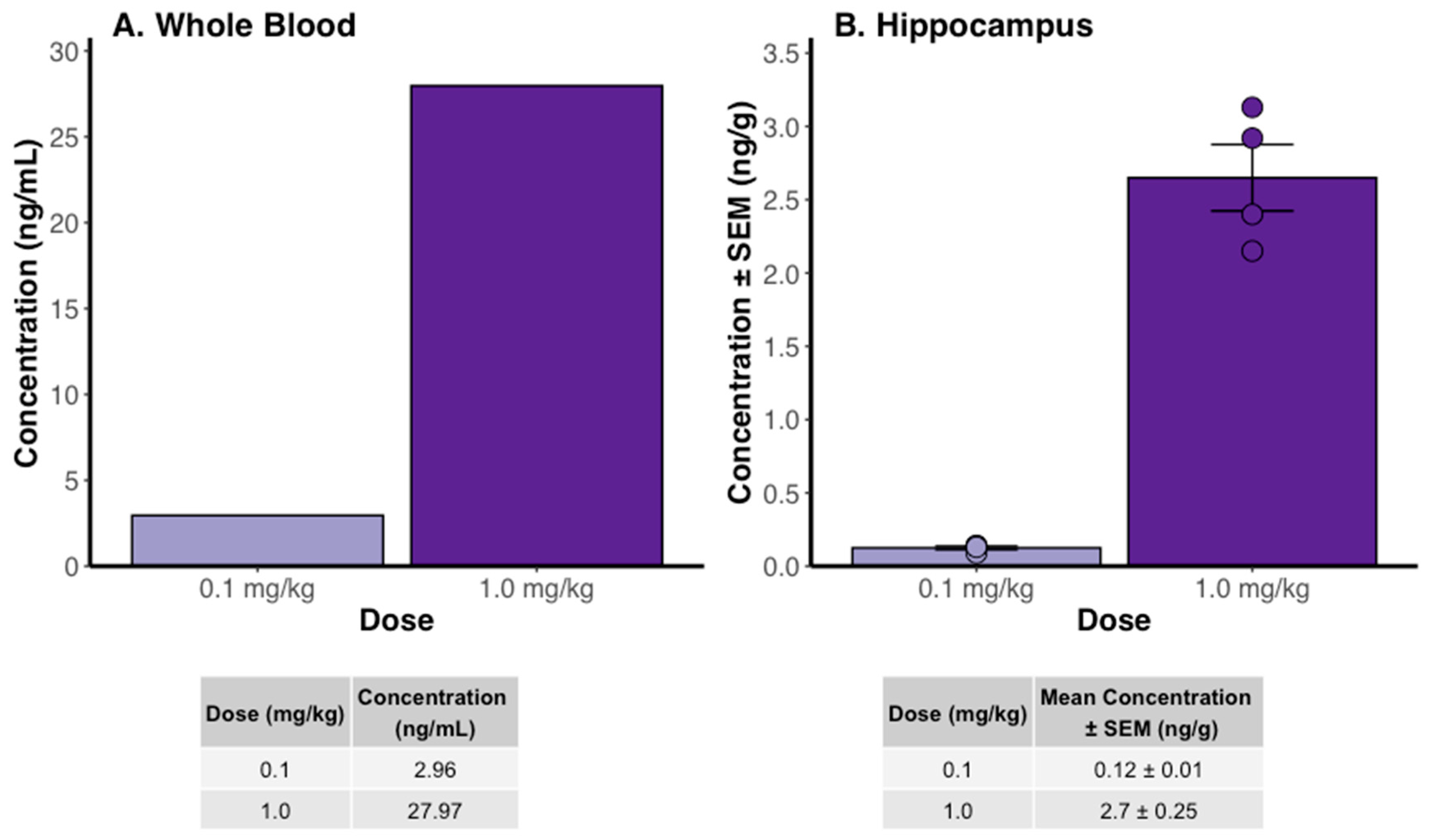
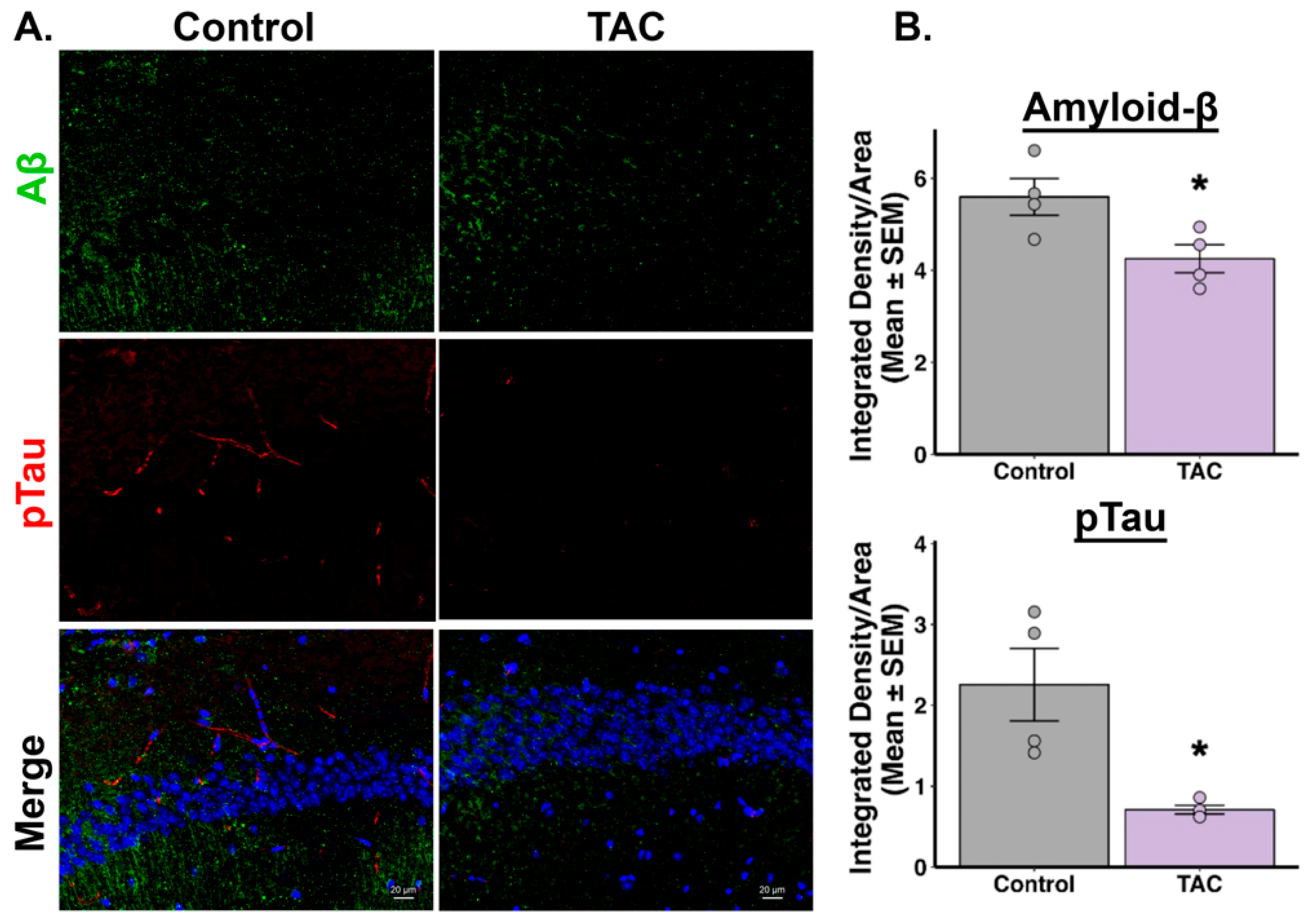
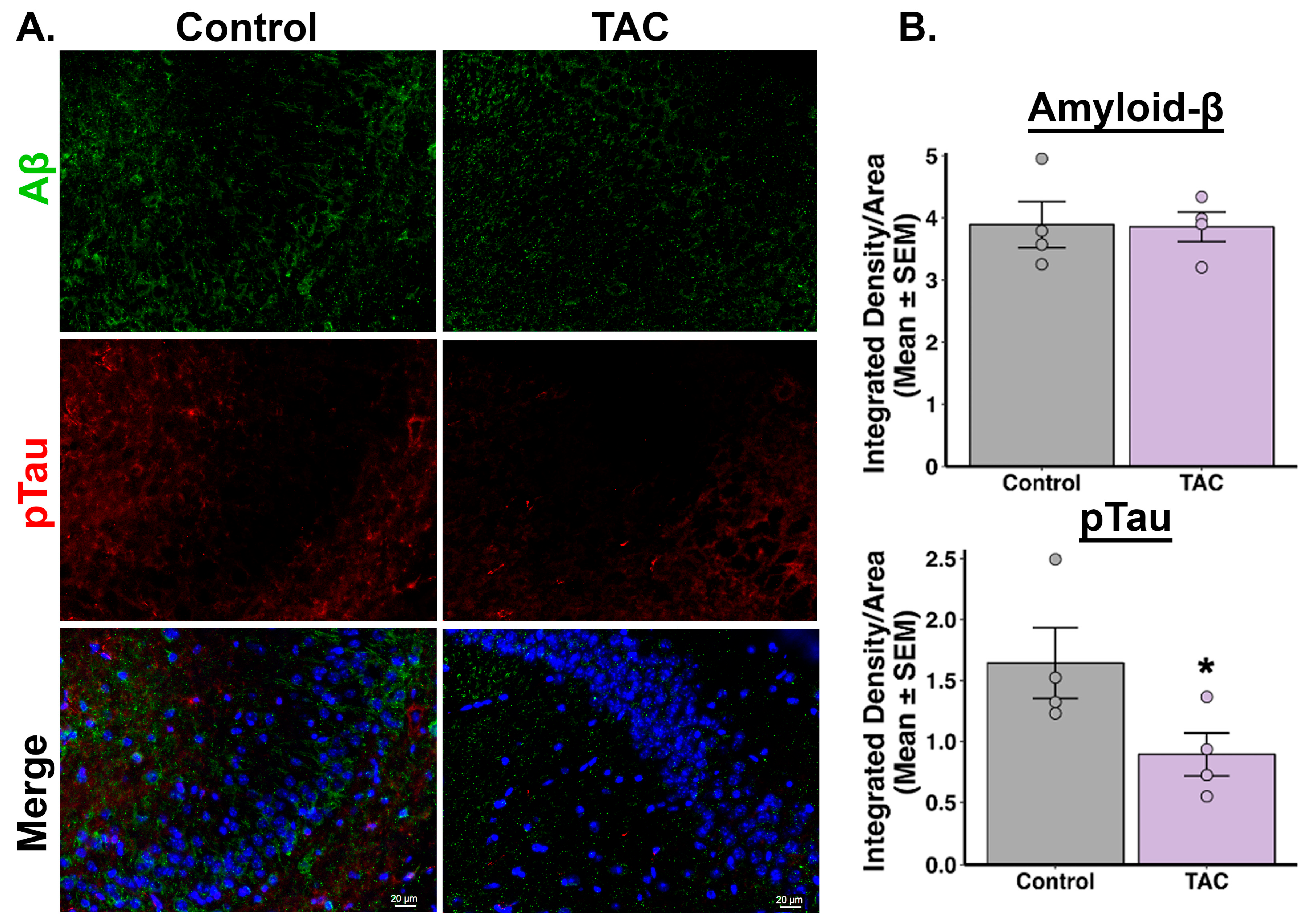

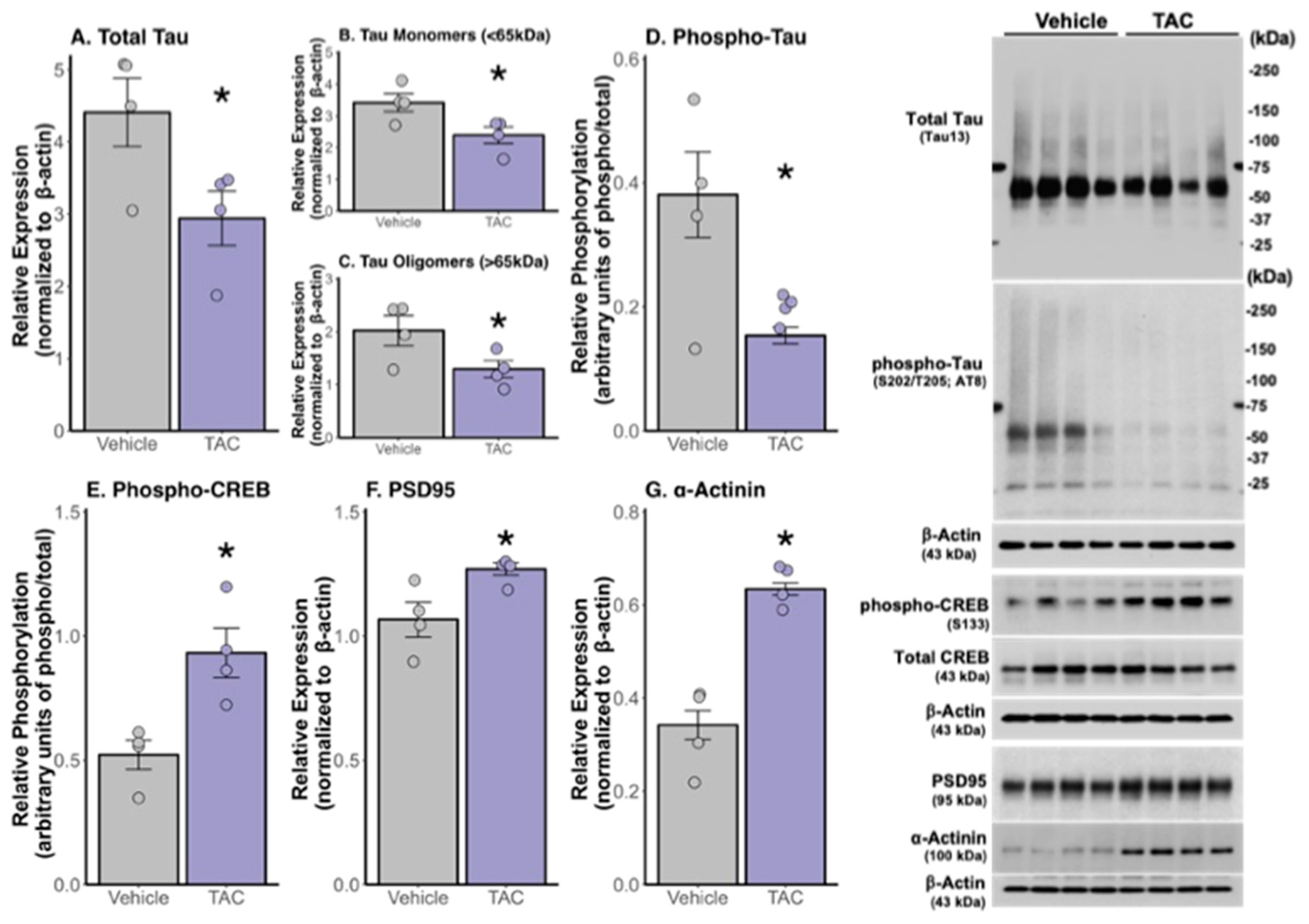
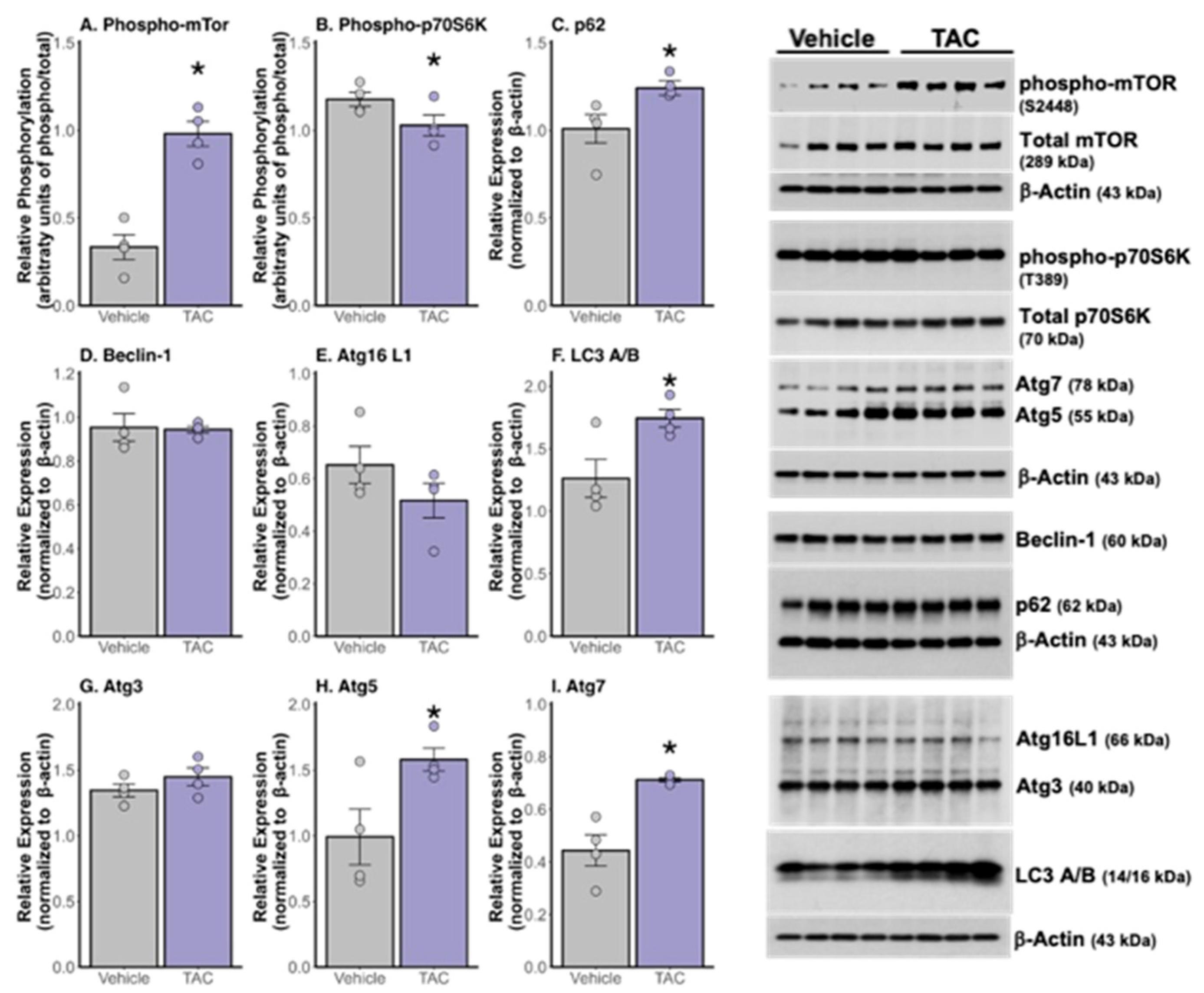
Disclaimer/Publisher’s Note: The statements, opinions and data contained in all publications are solely those of the individual author(s) and contributor(s) and not of MDPI and/or the editor(s). MDPI and/or the editor(s) disclaim responsibility for any injury to people or property resulting from any ideas, methods, instructions or products referred to in the content. |
© 2025 by the authors. Licensee MDPI, Basel, Switzerland. This article is an open access article distributed under the terms and conditions of the Creative Commons Attribution (CC BY) license (https://creativecommons.org/licenses/by/4.0/).
Share and Cite
Silva, J.; Tumurbaatar, B.; Guptarak, J.; Zhang, W.-R.; Fracassi, A.; Taglialatela, G. Sub-Immunosuppressive Tacrolimus Ameliorates Amyloid-Beta and Tau Pathology in 3xTg-AD Mice. Int. J. Mol. Sci. 2025, 26, 1797. https://doi.org/10.3390/ijms26051797
Silva J, Tumurbaatar B, Guptarak J, Zhang W-R, Fracassi A, Taglialatela G. Sub-Immunosuppressive Tacrolimus Ameliorates Amyloid-Beta and Tau Pathology in 3xTg-AD Mice. International Journal of Molecular Sciences. 2025; 26(5):1797. https://doi.org/10.3390/ijms26051797
Chicago/Turabian StyleSilva, Jacqueline, Batbayar Tumurbaatar, Jutatip Guptarak, Wen-Ru Zhang, Anna Fracassi, and Giulio Taglialatela. 2025. "Sub-Immunosuppressive Tacrolimus Ameliorates Amyloid-Beta and Tau Pathology in 3xTg-AD Mice" International Journal of Molecular Sciences 26, no. 5: 1797. https://doi.org/10.3390/ijms26051797
APA StyleSilva, J., Tumurbaatar, B., Guptarak, J., Zhang, W.-R., Fracassi, A., & Taglialatela, G. (2025). Sub-Immunosuppressive Tacrolimus Ameliorates Amyloid-Beta and Tau Pathology in 3xTg-AD Mice. International Journal of Molecular Sciences, 26(5), 1797. https://doi.org/10.3390/ijms26051797






